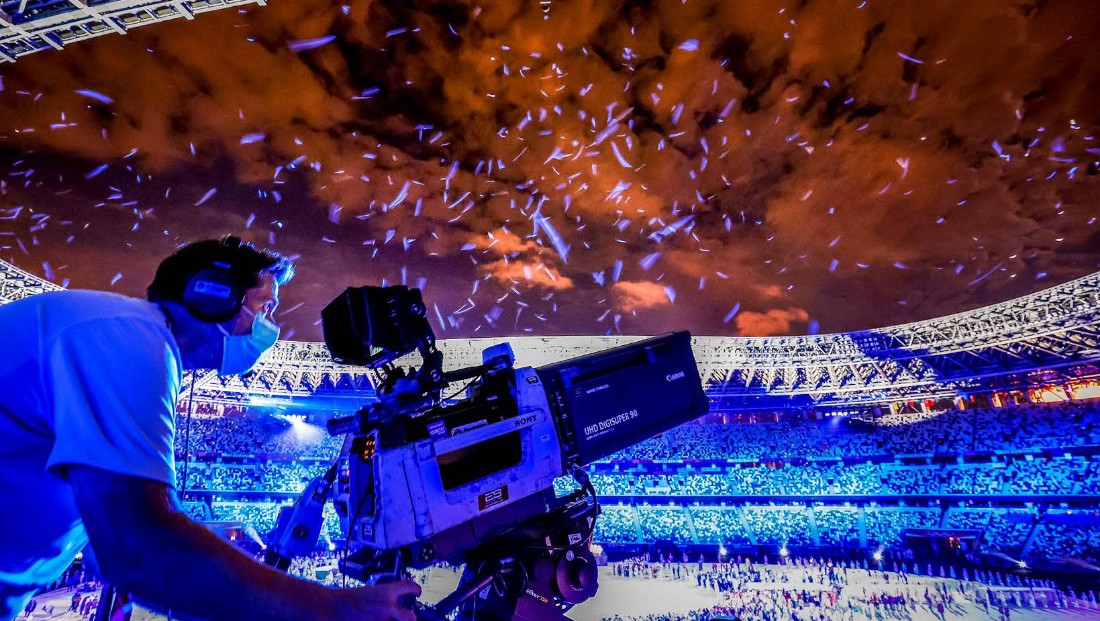Q&A: OBS on new technology and future of Olympic broadcasting

Subscribe to NCS for the latest news, project case studies and product announcements in broadcast technology, creative design and engineering delivered to your inbox.
Olympic Broadcasting Services coverage of the 2022 Winter Olympics includes 6,000+ hours of content with a variety of production firsts.
OBS Chief Technology Officer Sotiris Salamouris recently gave an interview for the OBS Media Guide about the advancements at these Games, including the UHD HDR production and use of 5G connected cameras, along with the future of Olympic broadcasting.
What effect has the short turnaround from Tokyo 2020 and the pandemic had on your preparations?
The people who work for OBS have several Games behind them so know what is involved in a cycle where we start preparing at least four years before. Soon after the host city is announced, we start preparing the large projects, most notably the telecommunication network that links the venues to the IBC and the IBC itself. Of course, as we are constantly getting closer to the Games, the preparations become more intense.
The situation in Beijing is different. We followed the standard pattern, but the postponement of the Tokyo 2020 Olympics was a big disruption. Normally, we would have a year and half from the end of the Olympic Games to the Olympic Winter Games when the final preparations take place.
This time, it was just a few months, which made our activation plans much more complex and dense. We were still working on Tokyo 2020 when under normal circumstances we would have exclusively been focusing on Beijing 2022.
The pandemic has been a big challenge since we were also not able to visit Beijing, except in a few exceptional cases, which meant we were working almost blind in situations when we would normally be on-site and visiting the venues.
OBS made a successful transition to UHD HDR and immersive audio in Tokyo. How satisfying is that to see and how will this be carried out and consolidated in Beijing?
Tokyo 2020 were definitely ground-breaking Games in terms of broadcast technology as we offered a large number of firsts.
The major change that we introduced at Tokyo 2020 was the full introduction of live coverage in UHD HDR, which was a breakthrough in format delivery for the Games’ live signal. Introducing UHD and HDR was much more challenging from when we introduced HD for the Beijing 2008 Olympics. UHD isn’t a small increase in data flow, it is eight times more than HD 1080i, which has been the standard of video delivery before Tokyo. This means a big change in all of the back-end systems and the technical infrastructure that can support such mega large bitrates.
In the end, we have developed one single live production workflow that was able to simultaneously deliver both UHD HDR and HD SDR, with exactly the same visual content and the only difference being the significantly enhancement in picture quality that comes from UHD together with HDR.
Surprisingly, our unified new UHD-HD workflow had one unexpected but extremely welcomed side-effect: It also contributed to improving the HD picture quality, due to the way that video content was converted from the much higher quality levels of UHD HDR to those of HD.
The picture quality in HD that we managed to achieve for the Tokyo 2020 Games could not have been possible if we had followed the traditional, HD-only, live production workflows from the past.
We are glad that the transition to UHD HDR went so well, and now, of course, we can count on that first experience in Tokyo when going into the Beijing 2022 Games.
How has OBS further moved its workflows to the cloud, and how will it benefit OBS and RHBs?
Alibaba is one of the four major public cloud providers in the world and they have created a very powerful cloud, upon which we have built specialised services and tools for the RHBs.
We have partnered with Alibaba and used their excellent support to build what we call the OBS Cloud. The OBS Cloud is essentially a framework of tools and services that we package together and offer to the RHBs to support their production and distribution workflows over public cloud.
OBS also uses it to support its own production workflows. Our content delivery platform, Content+, for instance, is fully hosted in the cloud and it is part of the OBS Cloud. RHBs can access our content, including the live sessions as they are happening, from wherever they are in the world, which helps simplify their workflows.
They can create their own highlights from their home offices in a far shorter turnaround.
Another ‘revolutionary’ example is our Live Cloud service, also part of OBS Cloud.
We successfully trialled such a live content delivery method in Tokyo, distributing live feeds to two RHBs on a pilot project basis.
When we decided to offer it as a standard service for the Beijing 2022 Games, we were so excited to see RHBs’ interest in the service. For these Games, more than 20 RHBs will be using Live Cloud to receive directly in their countries, over OBS Cloud, all the OBS multilateral live signals. What does our Live Cloud Video and Audio service achieve? Instead of highly expensive dedicated international telecommunication optical circuits, OBS is delivering all the live multilateral content, in contribution quality and in extra-high availability over public cloud.
This is truly amazing and, just a few years ago, would have seemed simply impossible to ever happen. The more extraordinary aspects of this service, which also explains its increasing popularity, is that it can already meet the transmission qualities often related to satellite distribution, in terms of latency and resilience, while it is already able to outperform it when it comes to expandability, flexibility, and consequently, cost. Lastly, what really surprised us was the fact that we can use Live Cloud not only to transmit our multilateral signals in HD, but in UHD as well, with the same resilience levels.
At Beijing 2022, how much of a role will 5G technology play?
Where, in Tokyo, we only used 5G-connected cameras for ENG coverage at the Ceremonies, for the Beijing 2022 operations, OBS will have nearly 30 5G-enabled cameras that will be used as part of our live coverage.
We will be using these cameras for several sports, such as alpine skiing, curling and cross-country skiing. All the tests that were performed have produced extremely positive results, offering us a lot of flexibility.
We have closely been working with Worldwide TOP Partner, Intel, who has helped us with the selection of the proper 5G Tx and Rx technology that goes with those cameras.
5G has great capacity to support low latency and high bandwidth live broadcast transmissions over a public infrastructure.
What progress has been made towards the use of AI technology in Olympic broadcasting?
We are moving closer to being able to integrate AI technology as part of our toolsets and using it for our video tagging workflow.
The way AI-powered broadcast applications are evolving, we are confident that it will give us greater flexibility in managing our content.
For Beijing 2022, we will produce more than 6,000 hours of content. If this content isn’t properly tagged, then it is very difficult to work with. For a long time, we have employed students through the OBS Broadcast Training Programme (BTP) to tag our live content. While we wouldn’t replace those students with an algorithm, AI would allow us to tag far more content. Video tagging is not a closed requirement that sometime in the future will be fully covered.
Tagging needs can be essentially open-ended if we consider that tagging always incorporates the particular interests and viewpoints behind the intended uses and applications. This is why AI is so promising for addressing the tagging or logging problem in video and audio as it will offer ultimate flexibility and expandability compared to the capabilities of human-only loggers.
We have our own technology, which we started developing ahead of Tokyo 2020, referred to as Automatic Media Description (AMD). It is becoming mature enough to be soon fully operational. We train the system to automatically search for specific content/video sequences, and once indexed, stitch this content together to produce quick highlights packages which are made available to OBS producers.
Another potential application is to use the same technology to search and find relevant content broadcasters are after such as clips with their NOC athletes, wherever they are and whatever they are performing within our videos. Although some athletes’ tagging is currently achieved by our loggers, it is practically impossible to tag all athletes in all available video frames − but this is often what the RHBs require. AMD is also being developed to satisfy this demand.
The uses for AI and machine learning in broadcast are constantly expanding. After Beijing 2022, we will start experimenting with automatic switching, which would mean using AI in live broadcast operations.
OBS will provide 8K coverage in collaboration with China Media Group (CMG) and NHK of Japan. How will this collaboration work?
We have been developing 8K for a decade, having begun at London 2012, and we now produce it alongside standard HD and UHD.
For these Games, OBS has collaborated with NHK and CMG as partners and content providers. We will be providing 8K coverage from selected competition venues and the National Stadium for Ceremonies, with OBS organising the consolidation to create a unified 8K multilateral feed.
We have found that 8K coverage has matured and the technology around it is moving quickly so that it will eventually become an option for more and more broadcasters. However, for now, 4K remains more viable as the current premium content format for live coverage, with 8K being used for specific high-end cases.
Can you tell us where you see the future of Olympic broadcasting?
The honest answer is that we don’t know for sure but we have to try our best to watch and review trends and developments, along with using our experience and imagination to make predictions. Then we need to take into account fast-changing technology and broadcasters’ requirements. We are in close contact with them and listen to their advice and act on their requests. To this end we organise a number of workshops, and we will have further discussions and brainstorming sessions at Beijing 2022.
The main requirement is that RHBs have access to the best content delivery and remote broadcast options for both their operations on-site and in their home countries.
Above all, broadcasters want flexibility and cost-efficiency in their workflows, and the move to IP and the availability of the cloud, increasingly allows them to have such options. Each broadcaster, of course, is different, and they have different needs and concerns, but all of them expect this flexibility, and I think this is where we are going to invest more in the future.
No matter if a broadcaster wants their coverage to come from the host city or their home base, they expect two things from the host broadcaster. First of all, to keep producing more content in different variations and formats because this is work that they themselves do not have to do. Secondly, it is about giving them a good selection of tools to help them efficiently deliver their final, unilateral coverage to their audiences. OBS must keep on investing time and effort for producing more and higher quality content, and also developing technical tools that help RHBs ingest and manage this content in the most efficient manner.
How can the implementation of new technologies and new workflows help with the sustainability of future Games and RHBs’ operations?
We have already mentioned the changing paradigm in broadcast technology, which is all about migrating all our applications and tools to IP, piggy backing on the ICT revolution. This same transition is the best path to tremendous overall efficiencies, and thus increase sustainability, which has been a key factor behind the adoption of virtualisation and, subsequently, the cloud. Both technological concepts are essentially all about high efficiency, that is one of the important ways to reduce waste and increase levels of sustainability.
Virtualisation is the starting step when moving into the cloud and is all about how one can take advantage of a particular piece of hardware in the most efficient manner. Thanks to virtualisation, hardware is now utilised to levels up to or more than 90 percent, a level that was unthinkable with previous approaches that were only relying on physical servers for running the applications software.
The cloud is the next step as it holds the highest possible density in terms of virtualised assets, together with a highly sophisticated and rich set of tools that allow the just-in-time use and management of this tremendous concertation of computational and networking capacity. There is not a more efficient manner to run applications of any sort. The data centres that house the cloud infrastructure are huge consumers of power and other resources. However, overall and for the total number of services that they are supporting, they do so in a far more efficient manner. They offer very high incentives for that efficiency to keep on improving, compared to running all these same services in stand-alone systems on-premise.
By moving all broadcast workflows into the cloud, we can reduce our footprint further − it is one of the fantastic opportunities offered by virtualisation.
Image courtesy of OBS.
Subscribe to NCS for the latest news, project case studies and product announcements in broadcast technology, creative design and engineering delivered to your inbox.








tags
2022 Winter Olympics, 4K Production, 5G, Alibaba, Artificial Intelligence, Cloud Broadcast Production, Intel, Metadata, OBS, Olympic Broadcasting Services, Remote Production
categories
4K, HDR and UHD Broadcasting, Acquisition, Broadcast Engineering, Content Delivery and Storage, Executive Q&A, Media Asset Management, Olympics, Sports Broadcasting & Production